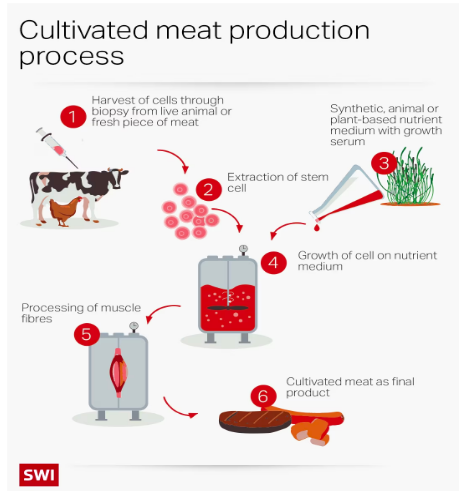Context:
Recently, two California-based companies were cleared to make and sell their cell-cultivated chicken in the USA.
- The first country to approve the sale of alternative meat was Singapore in 2020.

Image Source: swissinfo
About Cell-Cultivated Chicken:
- Cell-cultivated chicken, also known as cultured chicken or lab-grown chicken, refers to meat that is produced using cell culture techniques rather than traditional animal farming methods.
- Researchers are also developing cell-cultivated versions of sea bass, tuna, shrimp, and pork.
Challenges:
- Consumer Acceptance: Perfectly substituting animal meat with alternative meat requires the latter to match the former’s taste, texture, and appearance, and cost.
- Cost: The cost of cell-cultivated meat is expected to remain high in the near future.
- One 2020 analysis even concluded that it may never be cost-competitive, while reports have also expressed concerns about the costs imposed by quality control, especially at scale.
- Resources: For the cellular cultivation process, researchers require:
- high quality cells to begin with
- information about how different cell types contribute to the ‘meat’
- a suitable growth-medium in which the cells can be cultured
- other resources required to maintain the quality of the final product
Arguments in favour of developing Lab-grown meat:
- Climate Mitigation: The FAO has estimated that global livestock is responsible for 14.5% of all anthropogenic greenhouse-gas emission. Lab grown meat can reduce such emissions.
- With reduction in slaughterhouses, pollution of land and water can also be prevented.
- Customisation: Lab-grown meat can be customised to be healthier than their animal counterpart, such as being designed to contain less fat, thus contributing to public health
- Nutritional Security: Its proponents have also advanced such meat as a way to meet the world’s nutritional security and food security needs.
News Source: The Hindu
![]() 28 Jun 2023
28 Jun 2023
